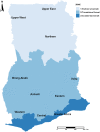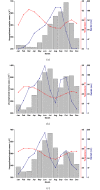Spatio-temporal heterogeneity of malaria morbidity in Ghana: Analysis of routine health facility data
- PMID: 29377908
- PMCID: PMC5788359
- DOI: 10.1371/journal.pone.0191707
Spatio-temporal heterogeneity of malaria morbidity in Ghana: Analysis of routine health facility data
Abstract
Background: Malaria incidence is largely influenced by vector abundance. Among the many interconnected factors relating to malaria transmission, weather conditions such as rainfall and temperature are known to create suitable environmental conditions that sustain reproduction and propagation of anopheles mosquitoes and malaria parasites. In Ghana, climatic conditions vary across the country. Understanding the heterogeneity of malaria morbidity using data sourced from a recently setup data repository for routine health facility data could support planning.
Methods: Monthly aggregated confirmed uncomplicated malaria cases from the District Health Information Management System and average monthly rainfall and temperature records obtained from the Ghana Meteorological Agency from 2008 to 2016 were analysed. Univariate time series models were fitted to the malaria, rainfall and temperature data series. After pre-whitening the morbidity data, cross correlation analyses were performed. Subsequently, transfer function models were developed for the relationship between malaria morbidity and rainfall and temperature.
Results: Malaria morbidity patterns vary across zones. In the Guinea savannah, morbidity peaks once in the year and twice in both the Transitional forest and Coastal savannah, following similar patterns of rainfall at the zonal level. While the effects of rainfall on malaria morbidity are delayed by a month in the Guinea savannah and Transitional Forest zones those of temperature are delayed by two months in the Transitional forest zone. In the Coastal savannah however, incidence of malaria is significantly associated with two months lead in rainfall and temperature.
Conclusion: Data captured on the District Health Information Management System has been used to demonstrate heterogeneity in the dynamics of malaria morbidity across the country. Timing of these variations could guide the deployment of interventions such as indoor residual spraying, Seasonal Malaria Chemoprevention or vaccines to optimise effectiveness on zonal basis.
Conflict of interest statement
Figures




Similar articles
-
Childhood malaria case incidence in Malawi between 2004 and 2017: spatio-temporal modelling of climate and non-climate factors.Malar J. 2020 Jan 6;19(1):5. doi: 10.1186/s12936-019-3097-z. Malar J. 2020. PMID: 31906963 Free PMC article.
-
Assessing the effectiveness of malaria interventions at the regional level in Ghana using a mathematical modelling application.PLOS Glob Public Health. 2022 Dec 21;2(12):e0000474. doi: 10.1371/journal.pgph.0000474. eCollection 2022. PLOS Glob Public Health. 2022. PMID: 36962718 Free PMC article.
-
Potential impact of climatic factors on malaria in Rwanda between 2012 and 2021: a time-series analysis.Malar J. 2024 Sep 10;23(1):274. doi: 10.1186/s12936-024-05097-5. Malar J. 2024. PMID: 39256741 Free PMC article.
-
Climatic Variables and Malaria Morbidity in Mutale Local Municipality, South Africa: A 19-Year Data Analysis.Int J Environ Res Public Health. 2017 Nov 8;14(11):1360. doi: 10.3390/ijerph14111360. Int J Environ Res Public Health. 2017. PMID: 29117114 Free PMC article.
-
A systematic review on lagged associations in climate-health studies.Int J Epidemiol. 2021 Aug 30;50(4):1199-1212. doi: 10.1093/ije/dyaa286. Int J Epidemiol. 2021. PMID: 33448301
Cited by
-
Preponderance of vaccine-preventable diseases hotspots in northern Ghana: a spatial and space-time clustering analysis from 2010 to 2014.BMC Public Health. 2022 Oct 12;22(1):1899. doi: 10.1186/s12889-022-14307-1. BMC Public Health. 2022. PMID: 36224589 Free PMC article.
-
Malaria micro-stratification using routine surveillance data in Western Kenya.Malar J. 2021 Jan 7;20(1):22. doi: 10.1186/s12936-020-03529-6. Malar J. 2021. PMID: 33413385 Free PMC article.
-
Trends of malaria infection in pregnancy in Ghana over the past two decades: a review.Malar J. 2022 Jan 4;21(1):3. doi: 10.1186/s12936-021-04031-3. Malar J. 2022. PMID: 34983534 Free PMC article. Review.
-
Spatial and spatio-temporal methods for mapping malaria risk: a systematic review.BMJ Glob Health. 2020 Oct;5(10):e002919. doi: 10.1136/bmjgh-2020-002919. BMJ Glob Health. 2020. PMID: 33023880 Free PMC article.
-
Spatio-temporal variation of malaria hotspots in Central Senegal, 2008-2012.BMC Infect Dis. 2020 Jun 17;20(1):424. doi: 10.1186/s12879-020-05145-w. BMC Infect Dis. 2020. PMID: 32552759 Free PMC article.
References
-
- National Malaria Control Program. An epidemiological profile of malaria and its control in Ghana. 2013. https://www.linkmalaria.org/sites/www.linkmalaria.org/files/content/coun.... Accessed 15 Feb 2016.
-
- Owusu-Agyei S, Nettey OEA, Zandoh C, Sulemana A, Adda R, Amenga-Etego S, et al. Demographic patterns and trends in Central Ghana: baseline indicators from the Kintampo Health and Demographic Surveillance System. Glob Health Action. 2012;5:19033 doi: 10.3402/gha.v5i0.19033 - DOI - PMC - PubMed
-
- Gyapong M, Sarpong D, Awini E, Manyeh AK, Tei D, Odonkor G, et al. Profile: The Dodowa HDSS. Int J Epidemiol. 2013;42:1686–96. doi: 10.1093/ije/dyt197 - DOI - PubMed
-
- Lacombe G, McCartney M, Forkuor G. Drying climate in Ghana over the period 1960–2005: evidence from the resampling-based Mann-Kendall test at local and regional levels. Hydrol Sci J. 2012;57:1594–609.
-
- Oduro AR, Wak G, Azongo D, Debpuur C, Wontuo P, Kondayire F, et al. Profile of the Navrongo Health and Demographic Surveillance System. Int J Epidemiol. 2012;41:968–76. doi: 10.1093/ije/dys111 - DOI - PubMed
MeSH terms
LinkOut - more resources
Full Text Sources
Other Literature Sources
Medical

